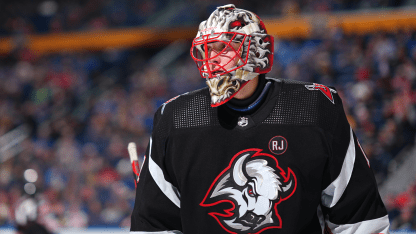Ukko-Pekka Luukkonen is having a breakout season with the Buffalo Sabres, but if you ask the 25-year-old goalie to identify the biggest factor in his success he is enjoying this season, he doesn’t point to a new tactic or technique.
Instead, Luukkonen credits the Sabres for giving him time to figure out what works for him in the NHL. Though there are changes in posture and positioning that triggered the recent rise, he points first to the team’s patience since picking him in the second round (No. 54) of the 2017 NHL Draft.
“I really do I appreciate the time I've been given from the coaching staff here and the whole organization to kind of take my time and find my footing in the net,” Luukkonen said. “I feel last year, in kind of an extended amount of games (33) in the NHL and trying to figure out what it is that I need to do to play well and then this year I am still relatively young obviously but still I could work during the summer and I could get better and I kind of found what I needed to do.”
Luukkonen’s season hit a speedbump on Thursday when he allowed eight goals on 39 shots in an 8-3 loss to the Edmonton Oilers.
But the Sabres’ patience has been rewarded with exceptional play from the 6-foot-5 goalie this season. Luukkonen is 23-18-3 while playing an NHL career-high 45 games. Among goalies to play at least 30 games, his .912 save percentage is tied for 10th in the League, his 2.39 goals-against average ranks seventh and his five shutouts are tied for third.
Before Thursday, Luukkonen had been even better since Dec. 30, going 17-9-1 with a .930 save percentage, 1.92 goals-against average and four shutouts. Since Jan. 11, he has started 26 of the Sabres 30 games, a 73-game pace.
It has helped the Sabres stay on the fringes of the playoff race; they enter Friday seven points behind the Detroit Red Wings for the second wild card into the Stanley Cup Playoffs from the Eastern Conference.
Luukkonen’s success and ability to play so much are tied to the above-mentioned work he did off the ice in Finland to get stronger through his legs and core, which has allowed him to hold his stance longer while also narrowing it, allowing him to be more patient waiting out shots and passes and avoid digging his edges in with a lower, wider stance that inherently limited his mobility.
“That's something we've been working on a couple past summers in Finland with a couple different goalie coaches but overall the message has been the same: to get my chest more up and get the feet a little narrower, [more] together, which has helped me a lot,” Luukkonen said, adding those changes have also improved his skating edgework and movement. “There's a lot that goes into it. You have to be strong from your core and hips and legs to be able to play a little more chest up and get that strength playing lower from the legs. That's one of the bigger things, just keeping the feet more narrow and having the chest more up.”
Maintaining a more upright chest allows Luukkonen to access his hands better by keeping them out in front; when a goalie hunches over at the waist and drops the chest, the natural tendency is to pull their hands back as a counterbalance. All of this has allowed Luukkonen to also stay deeper in his crease and let plays unfold longer in front of him before reacting rather than chasing the play.
When Seamus Kotyk, who has been the Sabres goalie development coach since Luukkonen was drafted, recently asked him what the biggest difference in his game this year was this season, he pointed to that change in depth.
“The biggest thing I felt has made the difference is keeping the play in front of you,” Luukkonen said he told Kotyk. “You don't let pucks get behind you or players get behind you because that's where the trouble is. So, the deeper you play, the more the play is in front of you and you allow yourself the best chance to make reads. You see the whole ice and you know there's nobody behind you because at this level if the game gets behind you, you're not in a good spot.”
Buffalo backup Eric Comrie noticed the difference in training camp.
“Right from Day One of camp I said, ‘holy, this guy is going to have a heck of a year,’” Comrie said. “He went from being the guy that would be stressed about making every single save in practice to a guy that understood 'hey, for the first drill I'm going to work on staying a little deeper in my net and working on reaction time' and I think it allowed him to understand depth management better at the NHL level because he would maybe chase the game a little early in his career. He's learned like, 'hey, I'm a big body, I can make saves deeper in my net if I have to' and he moves so dang well that he doesn't have to stress. He understands positioning now, his game is more well-rounded. I love watching him play.”
There are other factors to Luukkonen’s improvements.
Comrie and coach Don Granato each pointed to work ethic in practice. Luukkonen talked about all the video work he does with Sabres goalie coach Mike Bales, and how it has helped read plays that have become increasingly dynamic, with more east-west attacks in the NHL. Buffalo has also made huge strides defensively, which helps to simplify those reads for the goalie. Add it all up and you have a goalie hitting his stride in part because he’s not trying to force it.
“He cared too much before, tried too hard,” Comrie said. “He learned to let the game come to him.”
That, said Luukkonen, comes with time.
“When you come into the League as a younger goalie, you want to make the save every time really, really bad, which kind of forces you sometimes to be in the wider stance and the only thing you're thinking about is that 'I'm just going to make the save from the rush' and you don't do any favors to yourself with that thinking because then they make the play lateral and you automatically are kind of late because you're too focused on the puck carrier,” he said. “One of the things which comes with confidence is you read the play better and you're more confident to see the play and wait the situation out.”
Just like the Sabres were willing to do for Luukkonen.


















